Vitrinite Equivalent Reflectance Estimation from Improved Maturity Indicator and Well Logs Based on Statistical Methods
Abstract
:1. Introduction
2. Materials and Methods
- Hierarchical methods, showing the data structure and allowing for manual selection of the number of clusters;
- Non-hierarchical methods, in which the number of clusters is selected before the analysis and then the data are assigned to them, e.g., the k-means method.
3. Results
3.1. Core Data Domain
3.2. Well Log Domain
4. Discussion
5. Conclusions
- The parameter Im can be successfully used to estimate Ro in formations with a lower TOC content, provided that additional steps are used in its calculation, among other things, through the use of electrofacies.
- The use of cluster analysis and neural networks can be successfully used in the determination of electrofacies. The results obtained by both methods were similar.
- The use of resistivity log significantly improved the adjustment of the Im to Ro parameter. In the case of well A, the R2 coefficient increased from 0.77 to 0.94, and in the case of well B, it increased from 0.52 to 0.82. Importantly, the calculated RMSE error also decreased.
- The methodology used was applied to two different wells. In both cases, the calculated parameters were improved. The trend shift between the measured parameters is due to the different types of kerogen in the formation.
Author Contributions
Funding
Institutional Review Board Statement
Informed Consent Statement
Data Availability Statement
Acknowledgments
Conflicts of Interest
References
- Sadeghtabaghi, Z.; Talebkeikhah, M.; Rabbani, A.R. Prediction of vitrinite reflectance values using machine learning techniques: A new approach. J. Pet. Explor. Prod. 2020, 11, 651–671. [Google Scholar] [CrossRef]
- Antariksa, G.; Muammar, R.; Lee, J. Performance evaluation of machine learning-based classification with rock-physics analysis of geological lithofacies in Tarakan Basin, Indonesia. Journal of Petroleum Science and Engineering. Available online: https://www.sciencedirect.com/science/article/abs/pii/S0920410521009050 (accessed on 24 September 2021).
- Gu, Y.; Zhang, D.; Lin, Y.; Ruan, J.; Bao, Z. Data-driven lithology prediction for tight sandstone reservoirs based on new ensemble learning of conventional logs: A demonstration of a Yanchang member, Ordos Basin. J. Pet. Sci. Eng. 2021, 207, 109292. [Google Scholar] [CrossRef]
- Bolandi, V.; Kadkhodaie-Ilkhchi, A.; Alizadeh, B.; Tahmorasi, J.; Farzi, R. Source rock characterization of the Albian Kazhdumi formation by integrating well logs and geochemical data in the Azadegan oilfield, Abadan plain, SW Iran. J. Pet. Sci. Eng. 2015, Complete, 167–176. [Google Scholar] [CrossRef]
- Dubois, M.K.; Bohling, G.C.; Chakrabarti, S. Comparison of four approaches to a rock facies classification problem. Comput. Geosci. 2007, 33, 599–617. [Google Scholar] [CrossRef]
- He, J.; La Croix, A.D.; Wang, J.; Ding, W.; Underschultz, J.R. Using neural networks and the Markov Chain approach for facies analysis and prediction from well logs in the Precipice Sandstone and Evergreen Formation, Surat Basin, Australia. Mar. Pet. Geol. 2019, 101, 410–427. [Google Scholar] [CrossRef]
- Horrocks, T.; Holden, E.J.; Wedge, D. Evaluation of automated lithology classification architectures using highly-sampled wireline logs for coal exploration. Comput. Geosci. 2015, 83, 209–218. [Google Scholar] [CrossRef]
- Shen, C.; Asante-Okyere, S.; Ziggah, Y.Y.; Wang, L.; Zhu, X. Group Method of Data Handling (GMDH) Lithology Identification Based on Wavelet Analysis and Dimensionality Reduction as Well Log Data Pre-Processing Techniques. Energies 2019, 12, 1509. [Google Scholar] [CrossRef] [Green Version]
- Puskarczyk, E.; Jarzyna, J.A.; Wawrzyniak-Guz, K.; Krakowska, P.I.; Zych, M. Improved recognition of rock formation on the basis of well logging and laboratory experiments results using factor analysis. Acta Geophys. 2019, 67, 1809–1822. [Google Scholar] [CrossRef] [Green Version]
- Pavičić, I.; Briševac, Z.; Vrbaški, A.; Grgasović, T.; Duić, Ž.; Šijak, D.; Dragičević, I. Geometric and Fractal Characterization of Pore Systems in the Upper Triassic Dolomites Based on Image Processing Techniques (Example from Žumberak Mts, NW Croatia). Sustainability 2021, 13, 7668. [Google Scholar] [CrossRef]
- Kadkhodaie, A.; Rezaee, R. Estimation of vitrinite reflectance from well log data. J. Pet. Sci. Eng. 2017, 148, 94–102. [Google Scholar] [CrossRef] [Green Version]
- Poprawa, P. Lower paleozoic oil and gas shale in the baltic-podlasie-Lublin basin (Central and Eastern Europe)—A review. Geol. Q. 2020, 64, 515–566. [Google Scholar] [CrossRef]
- Lis, J. Analiza sedymentologiczna drobnoziarnistych osadów górnoordowicko-dolnosylurskich basenu podlasko-lubelskiego. Przegląd Geol. 2010, 58, 259–262. [Google Scholar]
- Ma, L.; Taylor, K.G.; Dowey, P.J.; Courtois, L.; Gholinia, A.; Lee, P.D. Multi-scale 3D characterisation of porosity and organic matter in shales with variable TOC content and thermal maturity: Examples from the Lublin and Baltic Basins, Poland and Lithuania. Int. J. Coal Geol. 2017, 180, 100–112. [Google Scholar] [CrossRef]
- Poprawa, P.; Pacześna, J. Rozwój ryftu w późnym neoproterozoiku-wczesnym paleozoiku na lubelsko-podlaskim skłonie kratonu wschodnioeuropejskiego—Analiza subsydencji i zapisu facjalnego. Prz. Geol. 2002, 50, 49–63. [Google Scholar]
- Podhalańska, T.; Feldman-Olszewska, A.; Roszkowska-Remin, J.; Janas, M.; Pachytel, R.; Głuszyński, A.; Roman, M. Prospective zones of unconventional hydrocarbon reservoirs in the cambrian, ordovician and silurian shale formations of the East European Craton marginal zone in Poland. Geol. Q. 2020, 64, 342–376. [Google Scholar] [CrossRef]
- Papiernik, B.; Botor, D.; Golonka, J.; Porębski, S.J. Unconventional hydrocarbon prospects in ordovician and silurian mudrocks of the East European Craton (Poland): Insight from three-dimensional modelling of total organic carbon and thermal maturity. Ann. Soc. Geol. Pol. 2019, 89, 511–533. [Google Scholar] [CrossRef]
- Bojanowski, M.J.; Kędzior, A.; Porębski, S.J.; Radzikowska, M. Origin and significance of early-diagenetic calcite concretions and barite from Silurian black shales in the East European Craton, Poland. Acta Geol. Pol. 2019, 69, 403–430. [Google Scholar] [CrossRef]
- Puskarczyk, E. Application of multivariate statistical methods and artificial neural network for facies analysis from well logs data: An example of Miocene deposits. Energies 2020, 13, 1548. [Google Scholar] [CrossRef] [Green Version]
- Shalaby, M.R.; Malik, O.A.; Lai, D.; Jumat, N.; Islam, M.A. Thermal maturity and TOC prediction using machine learning techniques: Case study from the Cretaceous–Paleocene source rock, Taranaki Basin, New Zealand. J. Pet. Explor. Prod. Technol. 2020, 10, 2175–2193. [Google Scholar] [CrossRef]
- Abarghani, A.; Ostadhassan, M.; Bubach, B.; Zhao, P. Estimation of thermal maturity in the Bakken source rock from a combination of well logs, North Dakota, USA. Mar. Pet. Geol. 2019, 105, 32–44. [Google Scholar] [CrossRef]
- Medellin, D.; Eghbali, A.; Wang, Y.; Torres-Verdín, C. Pore-size-dependent fluid substitution method for improved estimation of nmr porosity, permeability, and relaxation times. In Proceedings of the SPWLA 60th Annual Logging Symposium Transactions, The Woodlands, TX, USA, 15–19 June 2019; pp. 1–6. [Google Scholar] [CrossRef]
- Hussein, H.S.; Abdula, R.A. Multiple linear regression approach for the vitrinite reflectance estimation from well logs: A case study in Sargelu and Naokelekan Formations—Shaikhan-2 Well, Shaikhan oil field, Iraq. Egypt. J. Pet. 2018, 27, 1095–1102. [Google Scholar] [CrossRef]
- Sheikh, N.; Giao, P.H. Evaluation of shale gas potential in the Lower Cretaceous Sembar Formation, the Southern Indus Basin, Pakistan. J. Nat. Gas Sci. Eng. 2017, 44, 162–176. [Google Scholar] [CrossRef]
- Cheshire, S.; Craddock, P.R.; Xu, G.; Sauerer, B.; Pomerantz, A.E.; McCormick, D.; Abdallah, W. Assessing thermal maturity beyond the reaches of vitrinite reflectance and Rock-Eval pyrolysis: A case study from the Silurian Qusaiba formation. Int. J. Coal Geol. 2017, 180, 29–45. [Google Scholar] [CrossRef]
- Goodarzi, F.; Norford, B.S. Graptolites as indicators of the temperature histories of rocks. J. Geol. Soc. 1985, 142, 1089–1099. [Google Scholar] [CrossRef]
- Goodarzi, F. Organic petrography of graptolite fragments from Turkey. Mar. Pet. Geol. 1984, 1, 202–210. [Google Scholar] [CrossRef]
- Ferreiro Mählmann, R.; Le Bayon, R. Vitrinite and vitrinite like solid bitumen reflectance in thermal maturity studies: Correlations from diagenesis to incipient metamorphism in different geodynamic settings. Int. J. Coal Geol. 2016, 157, 52–73. [Google Scholar] [CrossRef]
- Petersen, H.I.; Schovsbo, N.H.; Nielsen, A.T. Reflectance measurements of zooclasts and solid bitumen in Lower Paleozoic shales, southern Scandinavia: Correlation to vitrinite reflectance. Int. J. Coal Geol. 2013, 114, 1–18. [Google Scholar] [CrossRef]
- Jacob, H. Classification, structure, genesis and practical importance of natural solid oil bitumen (“migrabitumen”). Int. J. Coal Geol. 1989, 11, 65–79. [Google Scholar] [CrossRef]
- Bertrand, R.; Malo, M. Dispersed Organic Matter Reflectance and Thermal Maturation in Four Hydrocarbon Exploration Wells in the Hudson Bay Basin: Regional Implications; Open File 7066; Geological Survey of Canada: Ottawa, BC, Canada, 2012; 52p. [Google Scholar] [CrossRef]
- Radke, M.; Welte, D.H.; Willsch, H. Maturity parameters based on aromatic hydrocarbons: Influence of the organic matter type. Org. Geochem. 1986, 10, 51–63. [Google Scholar] [CrossRef]
- Radke, M. Organic geochemistry of aromatic hydrocarbons. In Advances in Petroleum Geochemistry; Brooks, J., Welte, D.H., Eds.; Academic Press: London, UK, 1987; pp. 141–207. ISBN 978-0-12-032001-1. [Google Scholar]
- Zhao, P.; Ostadhassan, M.; Shen, B.; Liu, W.; Abarghani, A.; Liu, K.; Luo, M.; Cai, J. Estimating thermal maturity of organic-rich shale from well logs: Case studies of two shale plays. Fuel 2019, 235, 1195–1206. [Google Scholar] [CrossRef]
- Botor, D.; Kotarba, M.; Kosakowski, P. Petroleum generation in the Carboniferous strata of the Lublin Trough (Poland): An integrated geochemical and numerical modelling approach. Org. Geochem. 2002, 33, 461–476. [Google Scholar] [CrossRef]
- Kufrasa, M.; Krzywiec, P.; Gągała, Ł.; Mazur, S.; Mikołajczak, M. Sequence of deformation at the front of an orogen: Lublin basin case study (Poland). J. Struct. Geol. 2020, 141, 104211. [Google Scholar] [CrossRef]
- Kozłowska, A.; Waksmundzka, M.I. Diagenesis, sequence stratigraphy and reservoir quality of the Carboniferous deposits of the southeastern Lublin Basin (SE Poland). Geol. Q. 2020, 64, 422–459. [Google Scholar] [CrossRef]
- Poprawa, P. Geological setting and ediacaran–palaeozoic evolution of the western slope of the east european craton and adjacent regions. Ann. Soc. Geol. Pol. 2019, 89, 347–380. [Google Scholar] [CrossRef] [Green Version]
- Papiernik, B.; Michna, M. Methodology and results of digital mapping and 3d modelling of the lower palaeozoic strata on the East European Craton, Poland. Ann. Soc. Geol. Pol. 2019, 89, 405–427. [Google Scholar] [CrossRef] [Green Version]
- Kufrasa, M.; Stypa, A.; Krzywiec, P.; Słonka, Ł. Late Carboniferous thin-skinned deformation in the Lublin Basin, SE Poland: Results of combined seismic data interpretation, structural restoration and subsidence analysis. Ann. Soc. Geol. Pol. 2019, 89, 175–194. [Google Scholar] [CrossRef] [Green Version]
- Porębski, S.J.; Podhalańska, T. Ordovician–silurian lithostratigraphy of the east european craton in Poland. Ann. Soc. Geol. Pol. 2019, 89, 95–104. [Google Scholar] [CrossRef] [Green Version]
- Podhalańska, T. Graptolite biostratigraphy and dating of the ordovician–silurian shale succession of the sw slope of the east european craton. Ann. Soc. Geol. Pol. 2019, 89, 429–452. [Google Scholar] [CrossRef] [Green Version]
- Bator, D.; Golonka, J.; Zając, J.; Papiernik, B.; Guzy, P. Petroleum generation and expulsion in the Lower Palaeozoic petroleum source rocks at the SW margin of the East European Craton (Poland). Ann. Soc. Geol. Pol. 2019, 89, 153–174. [Google Scholar] [CrossRef] [Green Version]
- Tissot, B.P.; Welte, D.H. Sedimentary Processes and the Accumulation of Organic Matter. In Petroleum Formation and Occurrence; Springer: Berlin/Heidelberg, Germany, 1978; pp. 55–62. [Google Scholar]
- Hart, B.S.; Steen, A.S. Programmed pyrolysis (Rock-Eval) data and shale paleoenvironmental analyses: A review. Interpretation 2015, 3, SH41–SH58. [Google Scholar] [CrossRef]
- ASTM D7708-14. Standard Test Method for Microscopical Determination of the Reflectance of Vitrinite Dispersed in Sedimentary Rocks; ASTM: West Conshohocken, PA, USA, 2014. [Google Scholar]
- Espitalie, J.; Deroo, G.; Marquis, F. La pyrolyse Rock-Eval et ses applications. Première partie. Rev. l’Institut Français du Pétrole 1985, 40, 563–579. [Google Scholar] [CrossRef]
- Kiersnowski, H.; Dyrka, I. Ordovician-Silurian shale gas resources potential in Poland: Evaluation of Gas Resources Assessment Reports published to date and expected improvements for 2014 forthcoming Assessment. Przegląd Geol. 2013, 61, 354–373. [Google Scholar]
- Serra, O. Well Logging Handbook, 1st ed.; TECHNIP: Paris, France, 2008; ISBN 978-2-7108-0912-8. [Google Scholar]
- Ellis, D.V.; Singer, J.M. Basic Nuclear Physics for Logging Applications: Gamma Rays. Well Logging Earth Sci. 2007, 247–266. [Google Scholar] [CrossRef]
- Marsal, D.; Merriam, D.F. Statistics for Geoscientists; Elsevier: Amsterdam, The Netherlands, 1987; p. 176. [Google Scholar]
- Freund, R.J.; Wilson, W.J.; Sa, P. Regression Analysis. Statiscal Modeling of a Response Variable; Singer, T., Ed.; Elsevier Academic Press: Amsterdam, The Netherlands, 2006; ISBN 9780120885978. [Google Scholar]
- Kohonen, T. Self-Organized Formation of Topologically Correct Feature Maps. Biol. Cybern 1982, 43, 59–69. [Google Scholar] [CrossRef]
- Alizadeh, B.; Najjari, S.; Kadkhodaie-Ilkhchi, A. Artificial neural network modeling and cluster analysis for organic facies and burial history estimation using well log data: A case study of the South Pars Gas Field, Persian Gulf, Iran. Comput. Geosci. 2012, 45, 261–269. [Google Scholar] [CrossRef]
- Puskarczyk, E. Artificial neural networks as a tool for pattern recognition and electrofacies analysis in Polish palaeozoic shale gas formations. Acta Geophys. 2019, 67, 1991–2003. [Google Scholar] [CrossRef] [Green Version]
- Chang, H.C.; Kopaska-Merkel, D.C.; Chen, H.C. Identification of lithofacies using Kohonen self-organizing maps. Comput. Geosci. 2002, 28, 223–229. [Google Scholar] [CrossRef]
- Schmoker, J.W. Determination of Organic Content of Appalachian Devonian Shales from Formation-Density Logs: GEOLOGIC NOTES. Am. Assoc. Pet. Geol. Bull. 1979, 63, 1504–1509. [Google Scholar] [CrossRef]
- Passey, Q.R.; Creaney, S.; Kulla, J.B.; Moretti, F.J.; Stroud, J.D. A practical model for organic richness from porosity and resistivity logs. Am. Assoc. Pet. Geol. Bull. 1990, 74, 1777–1794. [Google Scholar]
- Waszkiewicz, S.; Karczewski, J.; Krakowska, P.; Jarzyna, J. Wyznaczanie całkowitej zawartości węgla organicznego TOC w skałach łupkowych z wykorzystaniem profilowań geofizyki otworowej na przykładzie danych z basenu bałtyckiego. Nafta-Gaz 2018, 74, 789–795. [Google Scholar] [CrossRef]
- Kethireddy, N.; Chen, H.; Heidari, Z. Quantifying the Effect of Kerogen on Resistivity Measurements in Organic-Rich Mudrocks. Petrophysics SPWLA J. Form. Eval. Reserv. Descr. 2014, 55, 136–146. [Google Scholar]
- Dabidian, N.; Heidari, Z.; Yang, A. Quantifying the impact of thermal maturity on dielectric permittivity of pure kerogen in organic-rich mudrocks. In Proceedings of the SPE/AAPG/SEG Unconventional Resources Technology Conference 2016, San Antonio, TX, USA, 1 August 2016; pp. 1–3. [Google Scholar] [CrossRef]
- Wood, D.A. Thermal maturity and burial history modelling of shale is enhanced by use of Arrhenius time-temperature index and memetic optimizer. Petroleum 2018, 4, 25–42. [Google Scholar] [CrossRef]
- Waliczek, M.; Machowski, G.; Poprawa, P.; Świerczewska, A.; Więcław, D. A novel VRo, Tmax, and S indices conversion formulae on data from the fold-and-thrust belt of the Western Outer Carpathians (Poland). Int. J. Coal Geol. 2021, 234, 103672. [Google Scholar] [CrossRef]
- Yang, A.; Firdaus, G.; Heidari, Z. Electrical resistivity and chemical properties of kerogen isolated from organic-rich mudrocks. Geophysics 2016, 81, D643–D655. [Google Scholar] [CrossRef]
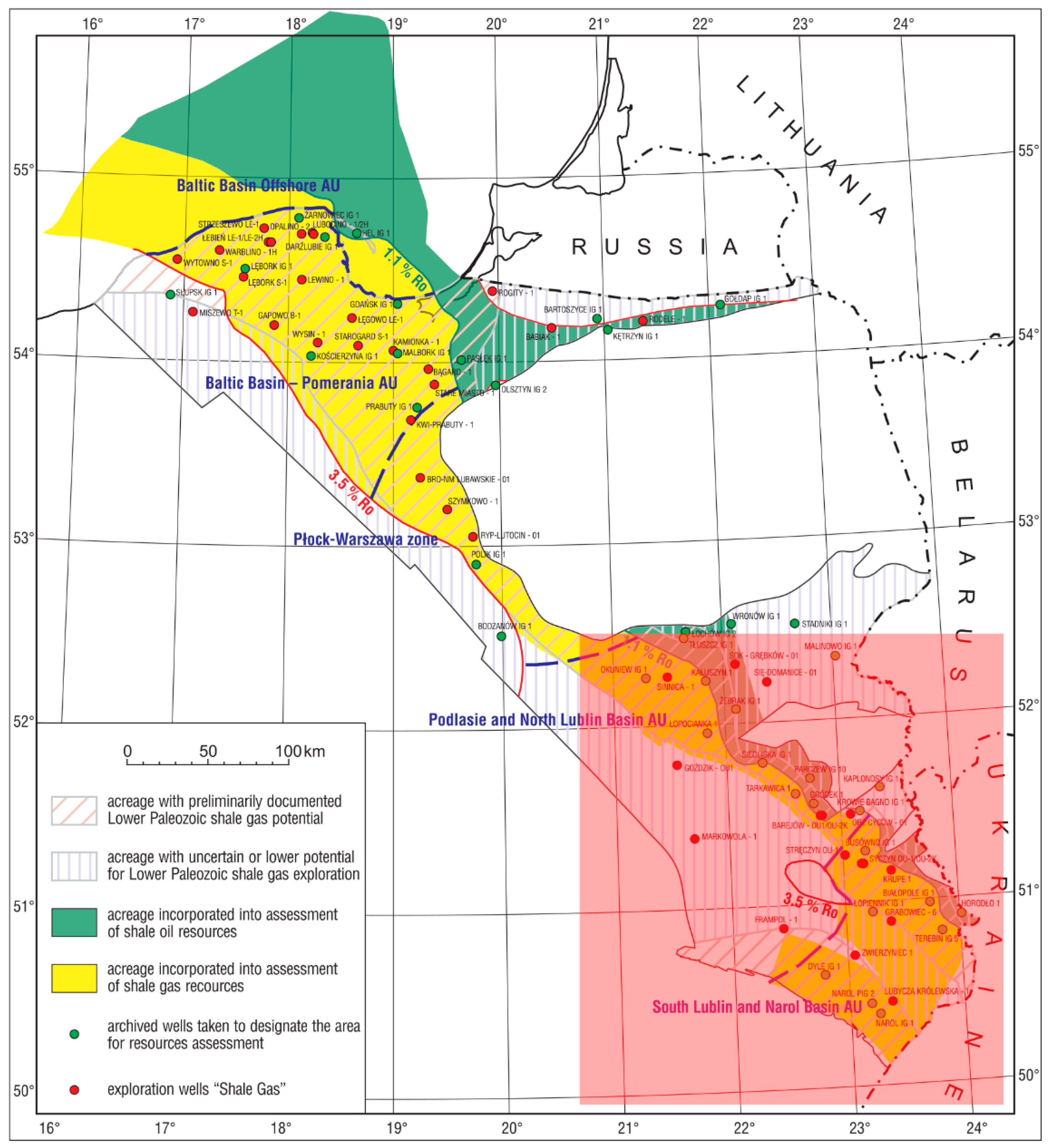
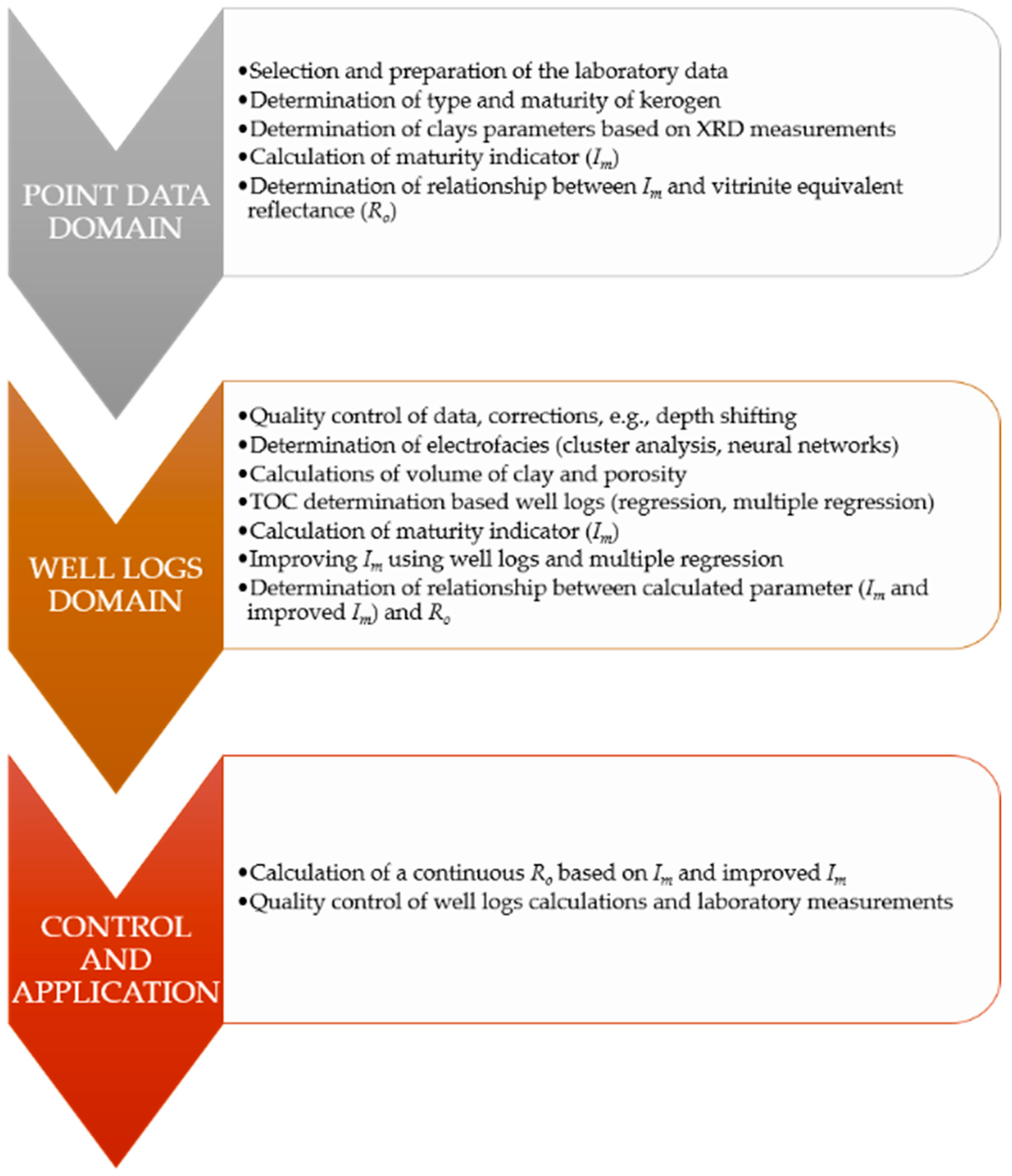

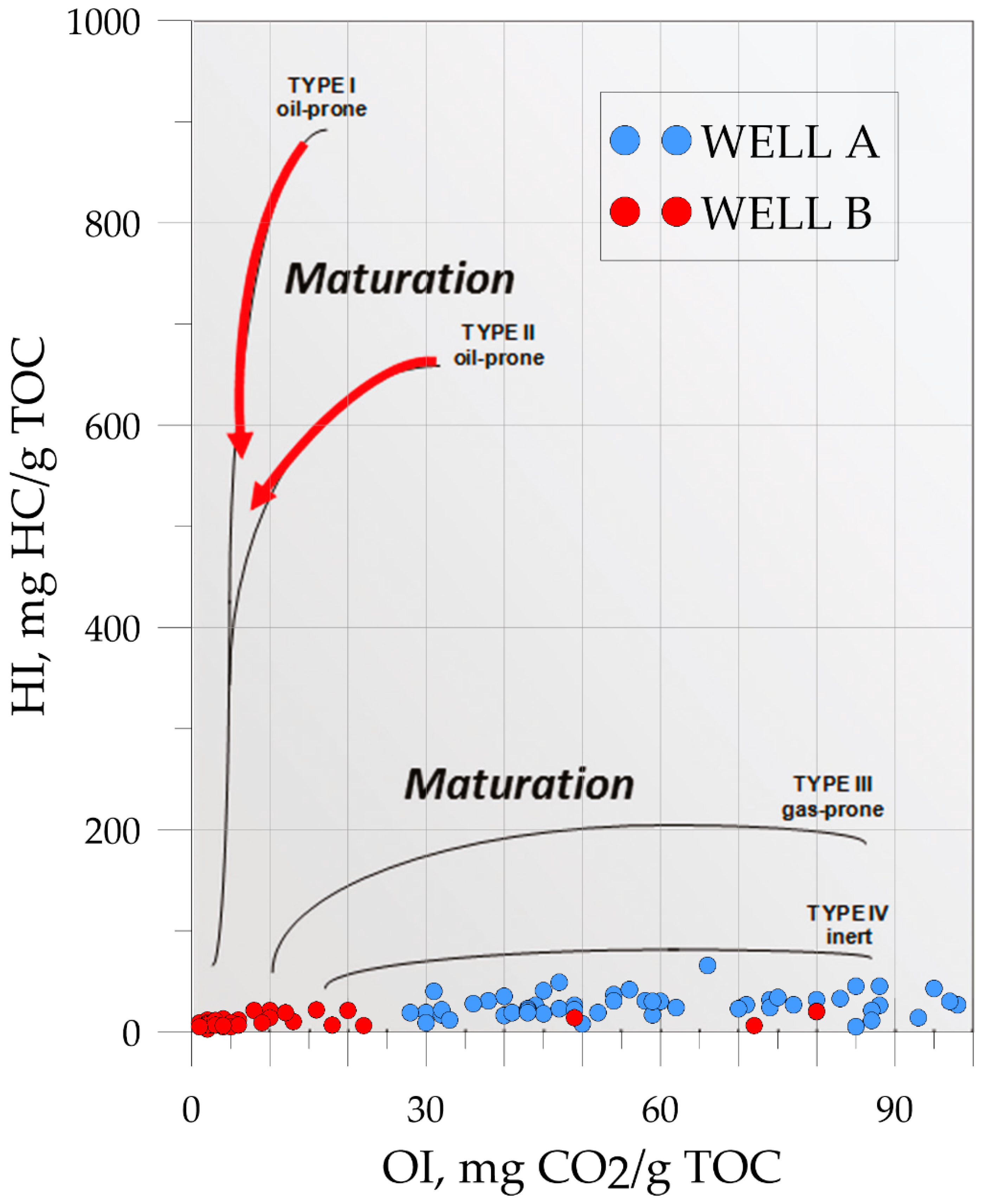
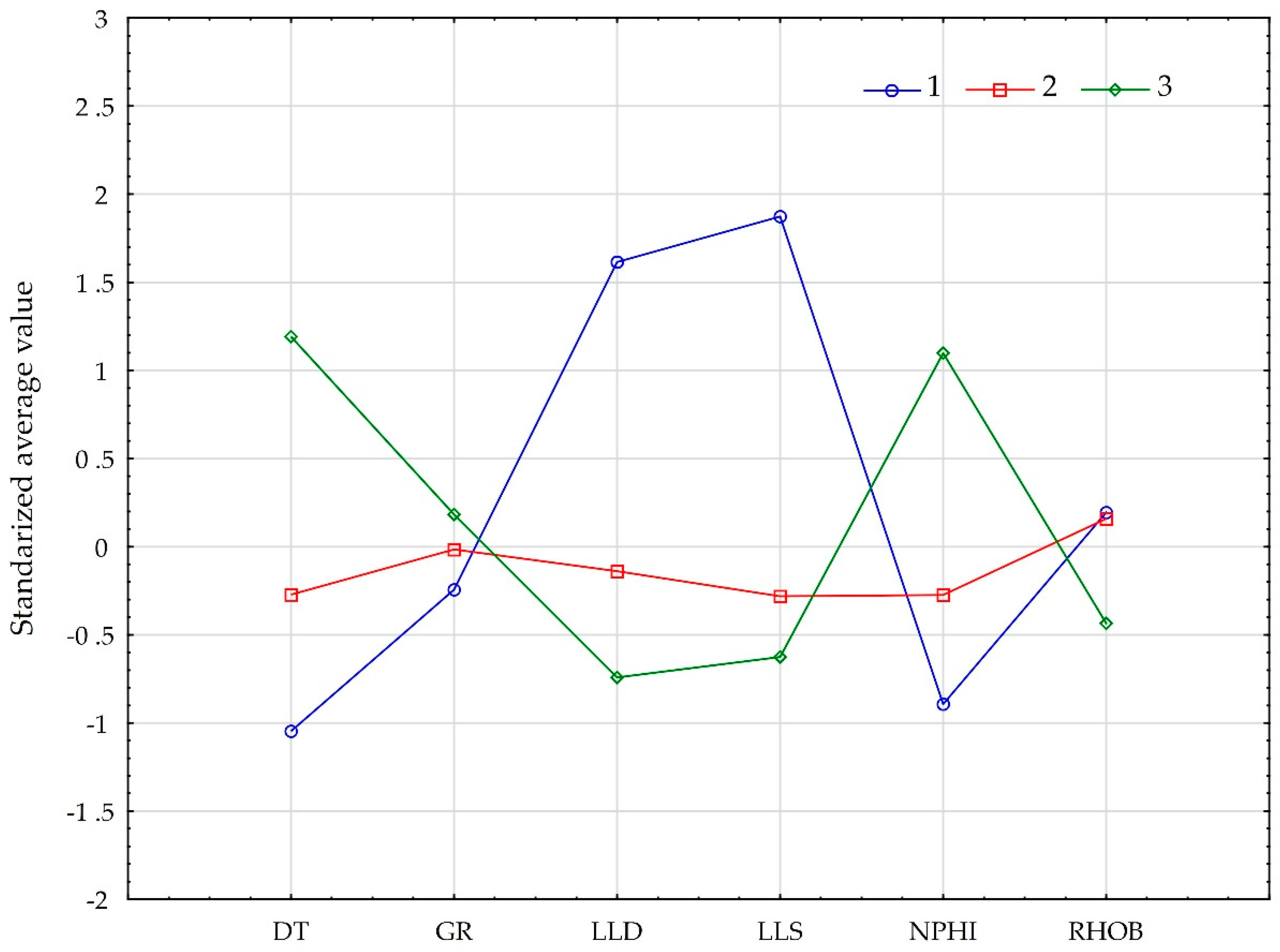
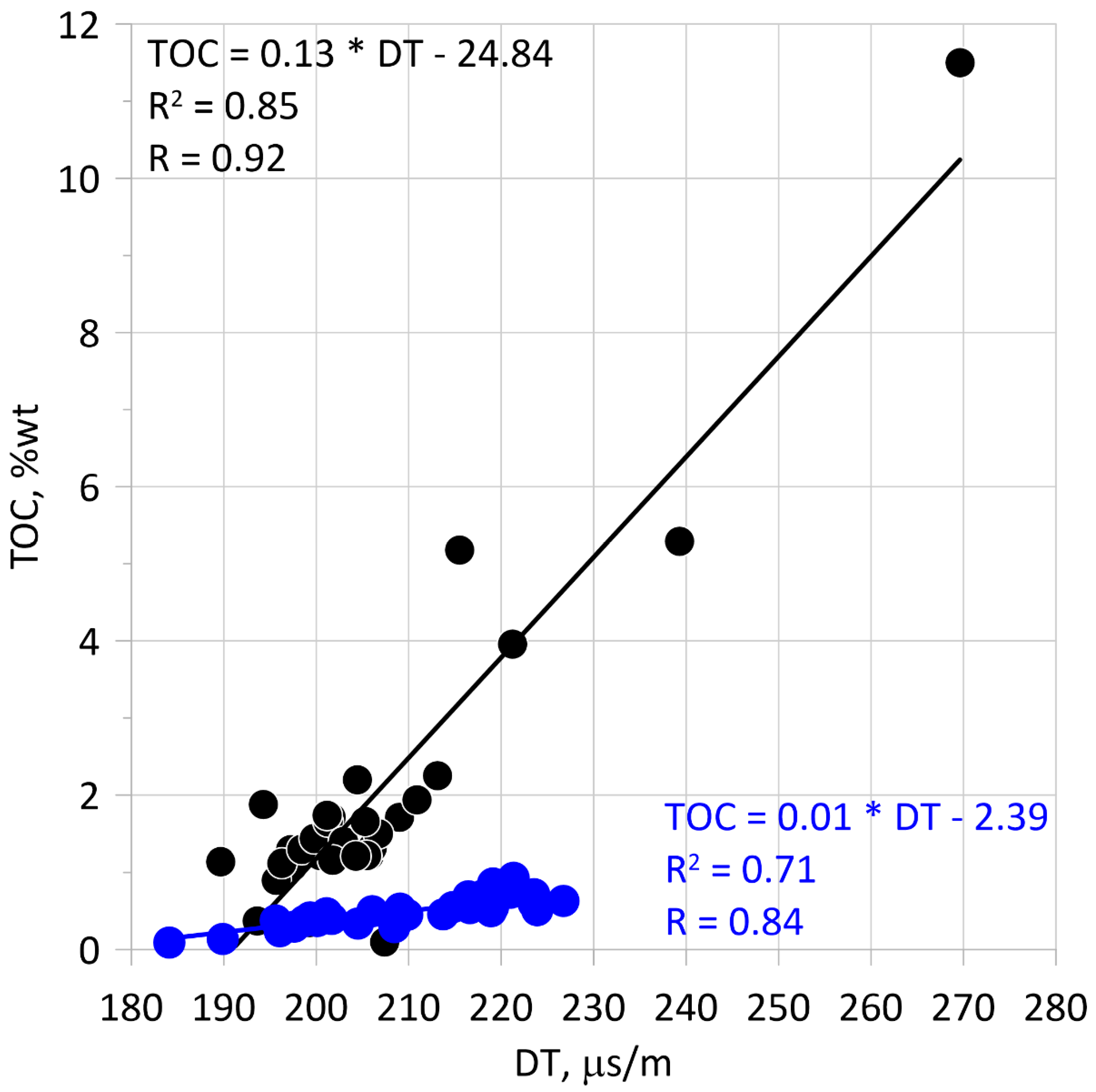
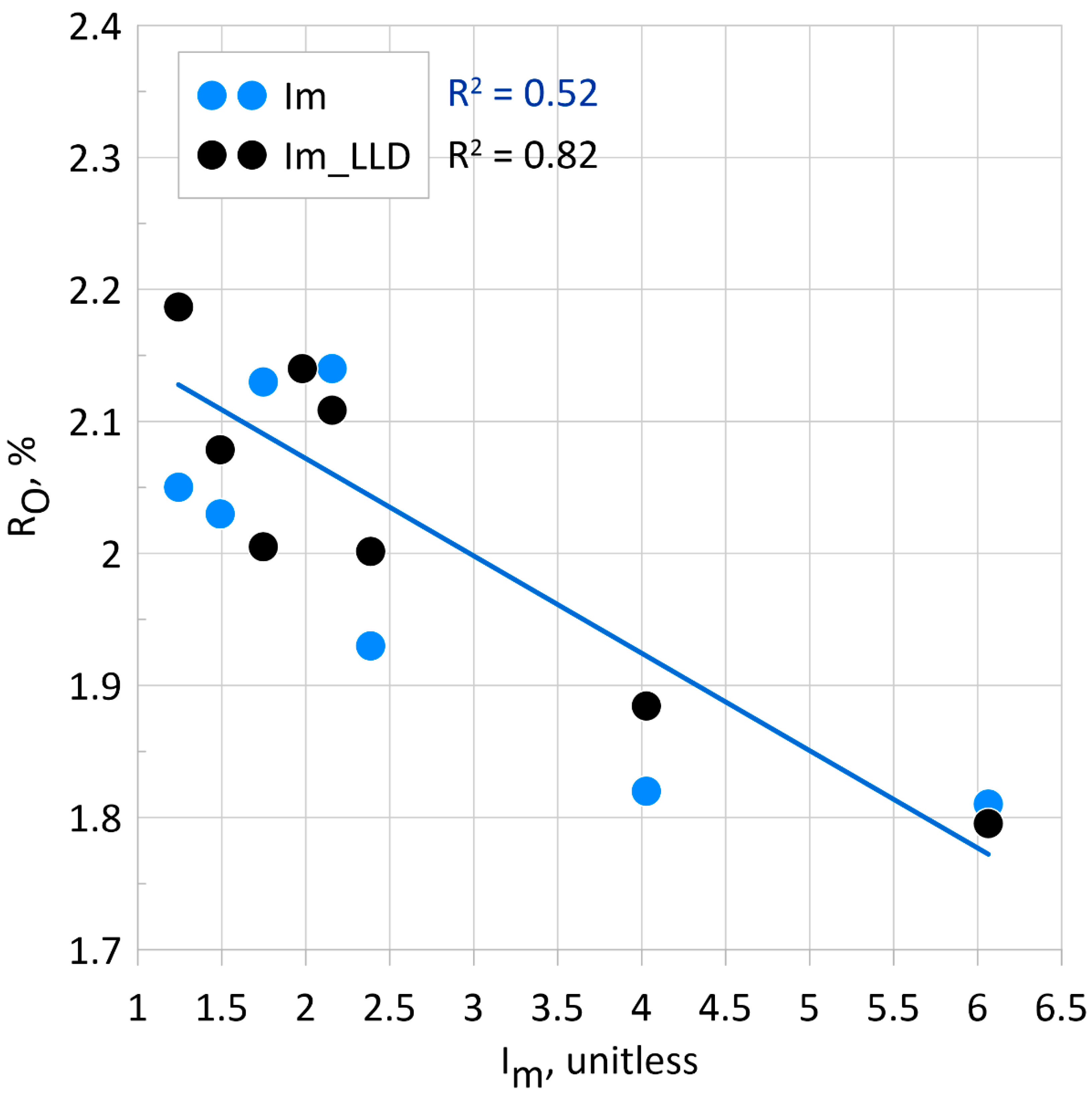

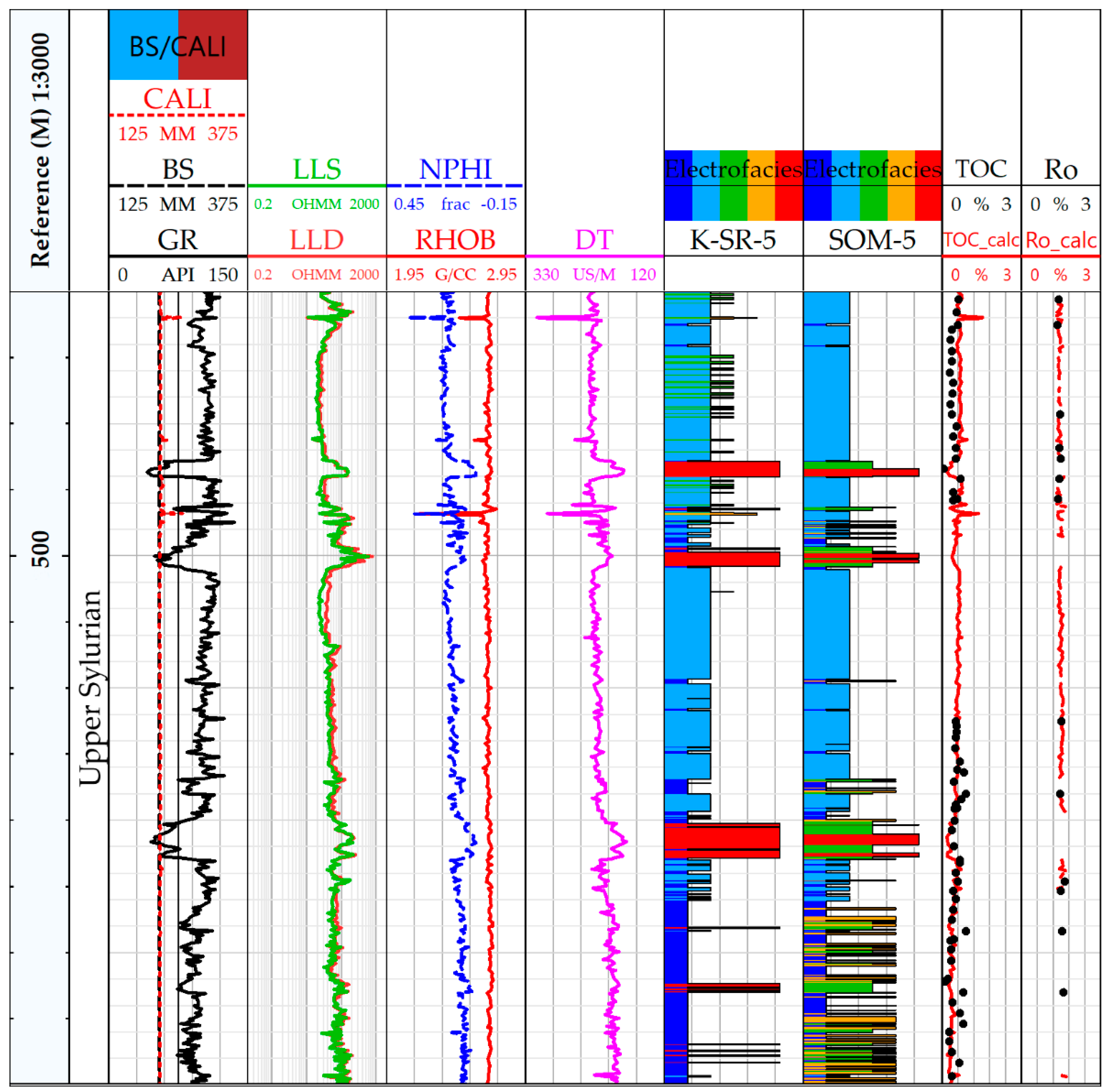

| Mineral | Responses (p.u.) |
|---|---|
| Quartz | −1 |
| Dolomite | 0.9 |
| Calcite | 0 |
| Pyrite | −1.7 |
| Illite | 9–10 |
| Kaolinite | 45 |
| Chlorite | Approximately 45 |
| Kerogen | 65 |
| WELL | DEPTH (m) | Ro(%) | TOC (%) | Clay (wt%) | Porosity (%) |
|---|---|---|---|---|---|
| WELL A | X413.01 | 1.37 | 0.63 | 47.2 | 5.32 |
| X446.74 | 1.47 | 0.38 | 62.4 | 3.96 | |
| X459.30 | 1.46 | 0.54 | 56.0 | 4.17 | |
| X463.37 | 1.51 | 0.55 | 57.4 | 6.97 | |
| X470.97 | 1.46 | 0.72 | 54.6 | 4.88 | |
| X476.22 | 1.41 | 0.43 | 51.5 | 3.84 | |
| X562.91 | 1.53 | 0.55 | 53.8 | 6.46 | |
| X590.20 | 1.48 | 0.93 | 53.5 | 5.68 | |
| X623.14 | 1.67 | 0.62 | 49.3 | 6.00 | |
| X642.08 | 1.56 | 0.93 | 57.8 | 4.13 | |
| X665.13 | 1.60 | 0.81 | 50.3 | 3.85 | |
| average | 1.50 | 0.64 | 54.0 | 5.02 | |
| WELL B | X603.00 | 2.09 | 0.26 | 59.5 | 7.75 |
| X614.53 | 2.18 | 0.15 | 61.1 | 8.56 | |
| X819.00 | 1.82 | 0.43 | 32.5 | 0.73 | |
| X829.02 | 1.81 | 0.71 | 43.5 | 1.83 | |
| X831.71 | 1.93 | 0.64 | 43.1 | 1.47 | |
| X161.00 | 2.14 | 1.29 | 46.6 | 2.58 | |
| X283.54 | 2.43 | 0.14 | 28.4 | 0.36 | |
| average | 2.06 | 0.52 | 45.0 | 3.36 |
| WELL | TOC Measured (%) | TOC Calculated (%) | ||||
|---|---|---|---|---|---|---|
| Average | Min | Max | Average | Min | Max | |
| Well A | 0.51 ± 0.17 | 0.09 | 0.93 | 0.53 ± 0.16 | 0.13 | 1.12 |
| Well B | 0.56 ± 0.85 | 0.02 | 11.5 | 0.49 ± 0.77 | 0 | 11.23 |
| WELL | Ro Measured (%) | Ro Calculated (%) | ||||
|---|---|---|---|---|---|---|
| Average | Min | Max | Average | Min | Max | |
| Well A | 1.47 ± 0.12 | 1.20 | 1.67 | 1.48 ± 0.06 | 1.29 | 1.72 |
| Well B | 2.09 ± 0.17 | 1.82 | 2.18 | 2.04 ± 0.08 | 1.69 | 2.28 |
Publisher’s Note: MDPI stays neutral with regard to jurisdictional claims in published maps and institutional affiliations. |
© 2021 by the authors. Licensee MDPI, Basel, Switzerland. This article is an open access article distributed under the terms and conditions of the Creative Commons Attribution (CC BY) license (https://creativecommons.org/licenses/by/4.0/).
Share and Cite
Waszkiewicz, S.; Krakowska-Madejska, P.I. Vitrinite Equivalent Reflectance Estimation from Improved Maturity Indicator and Well Logs Based on Statistical Methods. Energies 2021, 14, 6182. https://doi.org/10.3390/en14196182
Waszkiewicz S, Krakowska-Madejska PI. Vitrinite Equivalent Reflectance Estimation from Improved Maturity Indicator and Well Logs Based on Statistical Methods. Energies. 2021; 14(19):6182. https://doi.org/10.3390/en14196182
Chicago/Turabian StyleWaszkiewicz, Sebastian, and Paulina I. Krakowska-Madejska. 2021. "Vitrinite Equivalent Reflectance Estimation from Improved Maturity Indicator and Well Logs Based on Statistical Methods" Energies 14, no. 19: 6182. https://doi.org/10.3390/en14196182






